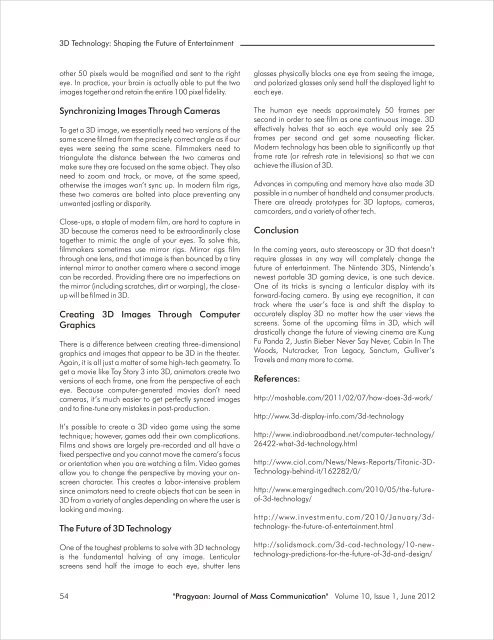Research Papers/Articles - Institute of Management Studies Dehradun
Research Papers/Articles - Institute of Management Studies Dehradun
Research Papers/Articles - Institute of Management Studies Dehradun
Create successful ePaper yourself
Turn your PDF publications into a flip-book with our unique Google optimized e-Paper software.
3D Technology: Shaping the Future <strong>of</strong> Entertainment<br />
other 50 pixels would be magnified and sent to the right<br />
eye. In practice, your brain is actually able to put the two<br />
images together and retain the entire 100 pixel fidelity.<br />
Synchronizing Images Through Cameras<br />
To get a 3D image, we essentially need two versions <strong>of</strong> the<br />
same scene filmed from the precisely correct angle as if our<br />
eyes were seeing the same scene. Filmmakers need to<br />
triangulate the distance between the two cameras and<br />
make sure they are focused on the same object. They also<br />
need to zoom and track, or move, at the same speed,<br />
otherwise the images won’t sync up. In modern film rigs,<br />
these two cameras are bolted into place preventing any<br />
unwanted jostling or disparity.<br />
Close-ups, a staple <strong>of</strong> modern film, are hard to capture in<br />
3D because the cameras need to be extraordinarily close<br />
together to mimic the angle <strong>of</strong> your eyes. To solve this,<br />
filmmakers sometimes use mirror rigs. Mirror rigs film<br />
through one lens, and that image is then bounced by a tiny<br />
internal mirror to another camera where a second image<br />
can be recorded. Providing there are no imperfections on<br />
the mirror (including scratches, dirt or warping), the closeup<br />
will be filmed in 3D.<br />
Creating 3D Images Through Computer<br />
Graphics<br />
There is a difference between creating three-dimensional<br />
graphics and images that appear to be 3D in the theater.<br />
Again, it is all just a matter <strong>of</strong> some high-tech geometry. To<br />
get a movie like Toy Story 3 into 3D, animators create two<br />
versions <strong>of</strong> each frame, one from the perspective <strong>of</strong> each<br />
eye. Because computer-generated movies don’t need<br />
cameras, it’s much easier to get perfectly synced images<br />
and to fine-tune any mistakes in post-production.<br />
It’s possible to create a 3D video game using the same<br />
technique; however, games add their own complications.<br />
Films and shows are largely pre-recorded and all have a<br />
fixed perspective and you cannot move the camera’s focus<br />
or orientation when you are watching a film. Video games<br />
allow you to change the perspective by moving your onscreen<br />
character. This creates a labor-intensive problem<br />
since animators need to create objects that can be seen in<br />
3D from a variety <strong>of</strong> angles depending on where the user is<br />
looking and moving.<br />
The Future <strong>of</strong> 3D Technology<br />
One <strong>of</strong> the toughest problems to solve with 3D technology<br />
is the fundamental halving <strong>of</strong> any image. Lenticular<br />
screens send half the image to each eye, shutter lens<br />
54<br />
glasses physically blocks one eye from seeing the image,<br />
and polarized glasses only send half the displayed light to<br />
each eye.<br />
The human eye needs approximately 50 frames per<br />
second in order to see film as one continuous image. 3D<br />
effectively halves that so each eye would only see 25<br />
frames per second and get some nauseating flicker.<br />
Modern technology has been able to significantly up that<br />
frame rate (or refresh rate in televisions) so that we can<br />
achieve the illusion <strong>of</strong> 3D.<br />
Advances in computing and memory have also made 3D<br />
possible in a number <strong>of</strong> handheld and consumer products.<br />
There are already prototypes for 3D laptops, cameras,<br />
camcorders, and a variety <strong>of</strong> other tech.<br />
Conclusion<br />
In the coming years, auto stereoscopy or 3D that doesn’t<br />
require glasses in any way will completely change the<br />
future <strong>of</strong> entertainment. The Nintendo 3DS, Nintendo’s<br />
newest portable 3D gaming device, is one such device.<br />
One <strong>of</strong> its tricks is syncing a lenticular display with its<br />
forward-facing camera. By using eye recognition, it can<br />
track where the user’s face is and shift the display to<br />
accurately display 3D no matter how the user views the<br />
screens. Some <strong>of</strong> the upcoming films in 3D, which will<br />
drastically change the future <strong>of</strong> viewing cinema are Kung<br />
Fu Panda 2, Justin Bieber Never Say Never, Cabin In The<br />
Woods, Nutcracker, Tron Legacy, Sanctum, Gulliver’s<br />
Travels and many more to come.<br />
References:<br />
http://mashable.com/2011/02/07/how-does-3d-work/<br />
http://www.3d-display-info.com/3d-technology<br />
http://www.indiabroadband.net/computer-technology/<br />
26422-what-3d-technology.html<br />
http://www.ciol.com/News/News-Reports/Titanic-3D-<br />
Technology-behind-it/162282/0/<br />
http://www.emergingedtech.com/2010/05/the-future<strong>of</strong>-3d-technology/<br />
http://www.investmentu.com/2010/January/3dtechnology-<br />
the-future-<strong>of</strong>-entertainment.html<br />
http://solidsmack.com/3d-cad-technology/10-newtechnology-predictions-for-the-future-<strong>of</strong>-3d-and-design/<br />
"Pragyaan: Journal <strong>of</strong> Mass Communication" Volume 10, Issue 1, June 2012


